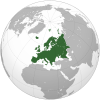Lietuva
外觀
Lietuva Kiōng-hô-kok Lietuvos Respublika | |
|---|---|
|
Kok-koa: Tautiška giesmė "Kok-ka ê sèng-si" | |
 | |
| Siú-to͘ kap siāng-tōa siâⁿ-chhī | Vilnius |
| Koaⁿ-hong gí-giân | Lietuva-gí |
| Chèng-hú | tan-it-chè, poàn-chóng-thóng-chè, kiōng-hô-kok |
• chóng-thóng | Gitanas Nausėda |
• chóng-lí | Ingrida Šimonytė |
• Seimas gī-tiúⁿ | Viktorija Čmilytė-Nielsen |
| Li̍p-hoat ki-kò͘ | Seimas |
| Bīn-chek | |
• Lóng-chóng | 65,300 km2 (25,200 sq mi) (tē 121 miâ) |
• chúi-he̍k (%) | 1.98 |
| Jîn-kháu | |
• 2021 nî kó͘-kè |
|
• Bi̍t-tō͘ | 43/km2 (111.4/sq mi) (tē 138 miâ) |
| GDP (PPP) | 2021 nî kó͘-kè |
• Lóng-chóng | $107 cha̍p-ek (tē 83 miâ) |
• Pêng-kin | $41,288 (tē 34 miâ) |
| GDP (bêng-gī) | 2021 nî kó͘-kè |
• Lóng-chóng | $56 cha̍p-ek (tē 80 miâ) |
• Pêng-kin | $22,752 (tē 38 miâ) |
| Gini (2019 nî) |
tiong |
| HDI (2019 nî) |
chin ko · tē 34 miâ |
| Hoè-pè | Euro (€) (EUR) |
| Sî-khu | UTC+2 (EET) |
• Hā-sî-kan (DST) | UTC+3 (EEST) |
| Sî-kan keh-sek | yyyy-mm-dd (CE) |
| Khui-chhia hong-hiòng | iū |
| Tiān-oē khu-hō | +370 |
| ISO 3166 tāi-hō | LT |
| Siōng-téng domain | .lt |
Lietuva (Lietuva-gí ho͘-im: [liɛtuvɑ] "Óa-im: "li-é-tu-bah"", liétubah), chèng-sek choân-miâ Lietuva Kiōng-hô-kok (Lietuva-gí: Lietuvos Respublika) sī tī Tang Au-chiu ê kok-ka, sī Baltic Kok-ka 3-kok ê kî-tiong 1 kok. Lietuva ê pak-hong sī Latvia, tang-lâm-hong sī Belarus, lâm-hong sī Pho-lân, sai-lâm-hong sī Lō͘-se-a ê Kaliningrad Chiu.
| |||||||||||||||||||||||||||||||||||||||||||||||
|
| Pún bûn-chiuⁿ sī chi̍t phiⁿ phí-á-kiáⁿ. Lí thang tàu khok-chhiong lâi pang-chō͘ Wikipedia. |



